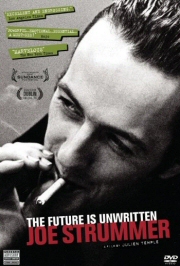 With the temperature dropping, it's time to find someone to keep you warm. Find your hookups with our online dating guide!
With the temperature dropping, it's time to find someone to keep you warm. Find your hookups with our online dating guide!
Joe Strummer
- Rock
- Unrated
- 2008
- Buy the DVD
Reviewed by Michael Fortes
()
eave it to the ultimate rock n’ roll buffoon, David Lee Roth, to provide an unintended bit of perspective in a documentary about a guy whose music rails against the type of establishment built by bands like Van Halen. “What these bands like the Clash need to realize is that you can’t take everything so goddamn seriously!”
Ah, but you can – and you can have fun while doing it!
Julien Temple’s closeness with, and empathy for, his subject is evident throughout all the little details of “The Future Is Unwritten,” Temple’s fantastic documentary on the late Joe Strummer. Nobody truly gets star treatment in the film – not Strummer’s celebrity friends and admirers, not the Clash’s contemporaries, not Diamond Dave, not even Strummer himself. True, his voice is heard throughout the film, taken from the “London Calling” radio program he hosted on the BBC during his later years, as well as various interviews. And yes, his image is splashed across the screen in old home movies, photographs and interview clips. Despite all this, the spirit and message of humanity that Strummer lived comes across much more strongly than a feeling of iconography or celebrity.
How Temple did this was amazingly simple. By filming the majority of his interviewees by the light of a campfire, the details of who these individuals are get lost to the night. Even though Bono is still wearing his trademark shades, and even though Johnny Depp is in full Pirates of the Caribbean regalia, they never seem more than equal to John Cusack, or Flea, or Clash drummer Topper Headon, or Strummer’s childhood friends, or anyone else. Of course, it also helps that Temple did not include identifying text on the screen and the subjects are never formally introduced to us. You have to figure all that out for yourself (or take a look at the DVD’s bonus interview footage, where all the subjects are clearly identified). In the end, they’re all people.
The campfire setting serves yet another purpose, namely a tribute to Strummer’s own affinity for campfires and the many such gatherings he held during the last decade of his life. This striving for a sense of community that marked so much of Strummer’s life almost makes the music feel secondary to the geo-political messages being spread by the man, though of course the punk, rock and reggae sounds of the Clash were a huge part of what made Strummer’s left-leaning politics so accessible. And there’s plenty of music to be heard throughout the film, from the 101’ers to the Mescaleros. One of the greatest thrills of the vintage Clash footage on display is watching Strummer sing “White Riot” in the studio. After seeing that clip, it becomes clear what made that performance so riveting – Strummer threw himself into the moment just as forcefully as he did when he was on stage.
Given the scope of the film, some parts of Clash history end up glossed over (Cut the Crap and the band’s demise) or completely ignored (working with producer Sandy Pearlman on the second album, Give ‘Em Enough Rope). What isn’t glossed over, however, are Strummer’s personal complexities, epitomized by his open admission on camera that he’d steal a friend’s girlfriend (and then we get proof in the account of how he slept with Headon’s).
The film’s aftertaste is strong – it lingers longer than most other documentaries, and for the better. Rather than just prompting a “wow!” or “that was awesome!” reaction, it inspires. Not necessarily to form a band, but to get up and do something that involves engaging with people. “Without people, you’re nothing,” Joe declares at the conclusion of the film. Truer words never spoken.
You can follow us on Twitter and Facebook for content updates. Also, sign up for our email list for weekly updates and check us out on Google+ as well.











